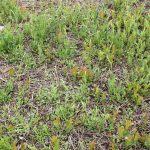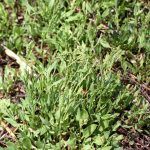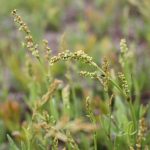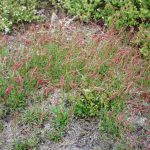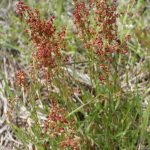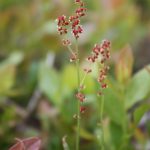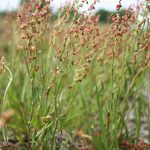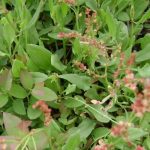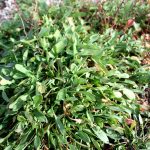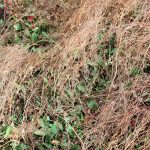Red sorrel
Prepared by Jennifer L. D’Appollonio, Assistant Scientist, University of Maine, Orono, ME 04469. Updated February 2018.
Scientific name: Rumex acetosella L.
Common name(s): red sorrel, common sheep sorrel, sheep dock
Links: USDA PLANTS Profile, Go Botany
Images: (to see enlargements [PC]: click on image, then right click and choose “view image”)
- pre-flower, May
- flowerbuds
- early flower, mid-May
- in flower, early June
- leaf detail
- November
- old flowers, November
Description:
– perennial
– flowers May-September.
Stems slender 6″-18″ arising from a crown. Alternate leaves distinctly arrow-shaped with broad lobes and bitter taste, 1″-4″ long. Red to yellow flowers at top of the plant, small and clustered in a whorl, male and female flowers on separate plants.
-Produces large quantities of pollen
-may be confused with R. acetosa; see left sidebar on Go Botany webpage
Habitat
- Enjoys moist, low in fertility, acidic, fast draining soils
- open grasslands or meadows, and gravely or recently burned areas
Natural History
- Introduced from Europe and in the 19th Century
- Edible to humans and used as a green or to make tea
- Found toxic to livestock if eaten in high amounts
- Historic medical uses
- treating kidney problems, skin disorders and sore throats
- inflammation, scurvy, cancer, diarrhea
- An antidote for poisons by indigenous people
Management
- hand pulling
- Mulch and Fertilizers
- suppression by mulch
- altering pH
- Herbicides/chemicals
- pre emergence suppression
- growth regulators
- aromatic amino acid inhibitors
- photosynthetic inhibitors
Sources:
DiTomaso, J.M., G.B. Kyser et al. 2013. Weed Control in Natural Areas in the Western United States. Weed Research and Information Center, University of California. 544 pp.
Peacock, Charles. “Red Sorrel: NC State Extension Publications.” Red Sorrel | NC State Extension Publications, 2017, content.ces.ncsu.edu/red-sorrel.
“Red Sorrel (Sheep Sorrel).” University of Maryland Extension, 2020, extension.umd.edu/hgic/topics/red-sorrel-sheep-sorrel.

